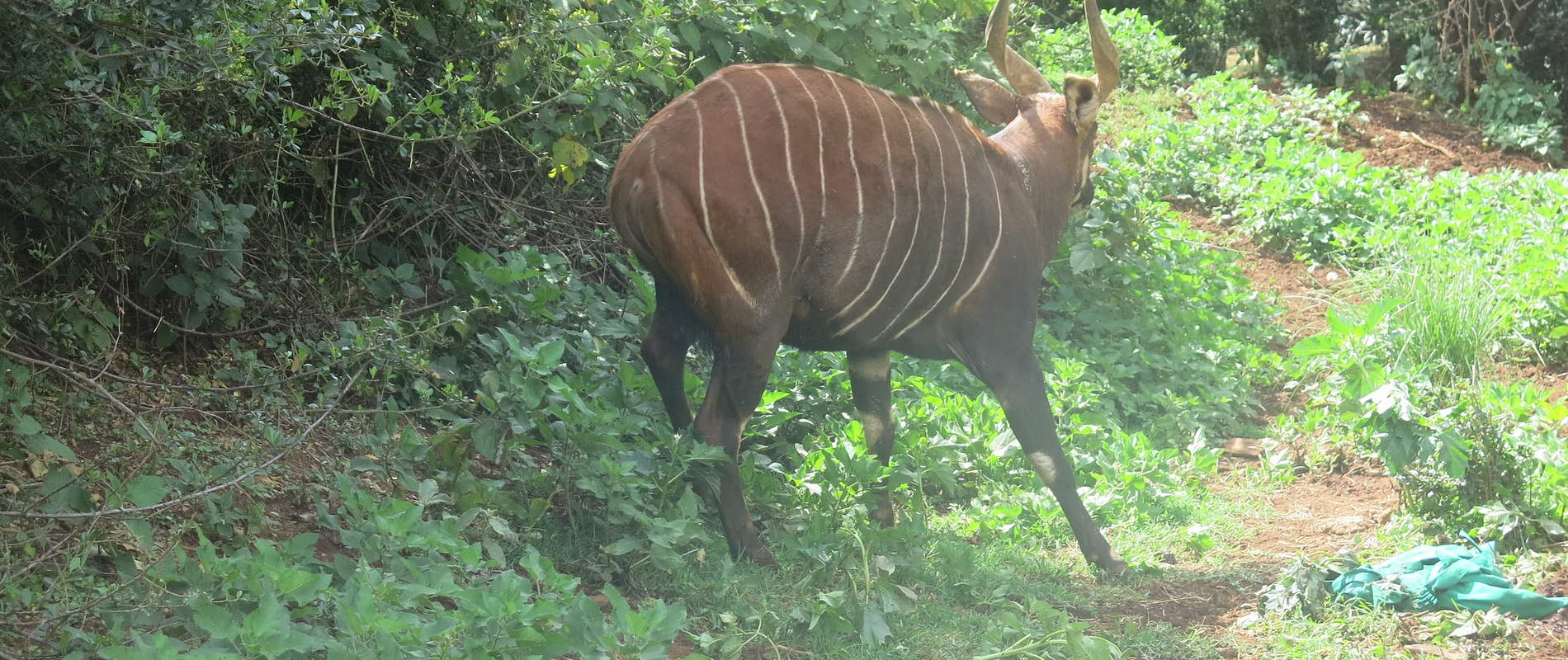Introduction This report describes the activities of the DSWT/KWS Meru Veterinary Unit operating in northern Kenya in July 2017
Introduction
This report describes the activities of the DSWT/KWS Meru Veterinary Unit operating in northern Kenya in July 2017.
Through July 6 – 14, the unit collaborated with KWS rangers, veterinarians, scientists and pilots to ear notch 37 black rhino in Solio ranch. This activity was funded by WWF Kenya and implemented by the KWS.
In Ol Pejeta conservancy, we attended to a black rhino which showed severe lameness and in Mount Kenya game ranch a mountain bongo which suffered an avulsion injury on its thigh needed surgical treatment.
1. RHINO EAR NOTCHING IN SOLIO RANCH
History
On July 6 – 14, 2017 the Meru veterinary unit participated in ear notching and microchip insertion in black rhinoceros (Diceros bicornis) in Solio ranch. Thirty-seven (37) rhinos were ear notched consisting 21 females and 16 males and a record for individual identification of each black rhino ear notched were developed for monitoring.
Ear notching enables individual identification of rhinos for monitoring in the wild. The Conservation and Management Strategy for Black Rhino in Kenya (2012 – 2017) aims at 60% identifiable independent animals in each population by all trained observers.


Black rhinos (Diceros bicornis) selected for ear notching were individuals more than three years old that had not been ear notched described as clean animals. This selection criterion was used to minimize risk associated with post immobilization separation of calves which are dependent on their mother for nutrition and nurture.




Animals were darted from a helicopter with a Dan-inject rifle (Dan-inject APS, Sellerup Skowej, Denmark) using 2ml or 3ml Dan-inject darts. Etorphine Hcl (0.98%) (M99®)(Norvatis South Africa (Pty) Ltd and Azaperone Tartrate (10%) (Kyron Laboratories (Pty) Ltd)South Africa, combination was used to induce and maintain anaesthesia of candidate rhinos. Anesthesia in black rhinoceros was reversed using Diprenorphine Hcl given by intravenous route.
2. LAMENESS IN A BLACK RHINO
Date: 08/07/17
Species: Black rhino
Sex: Female
Age: 4.7 years
Location: Ol Pejeta conservancy
History
On 05/07/17 a sub-adult black rhino in Ol Pejeta conservancy was reported to have shown severe progressive swelling and lameness on its left front leg over the past one month. The Meru veterinary unit visited the conservancy on 06/07/17 to examine this rhino.

However, it disappeared into the thickets and we did not find it. On 08/07/17, when it was found its body condition had deteriorated. Sadly by the time we arrived we found it had drowned in river when it attempted to cross. Post mortem examination showed a fracture of the metacarpal bones and bone infection.
3. WOUND TREATMENT ON A BONGO
Date: 18/7/17
Name: Riziki
Species: Bongo
Sex: Male
Age: Adult
Location: Mount Kenya Game Ranch
History
Riziki is reported to have sustained soft tissue injury on its left thigh when it jumped over a gate at the Mount Kenya Game ranch at night on 16/07/17. The gate has sharp spikes which punctured its left thigh. It was immobilized for examination and treatment on 18/07/17
Chemical immobilization and findings
Etorphine 6mg and Azaperone 50mg in a 1.5cc dart with 2.0 × 40mm needle
Darted at 1323 hr into the right thigh muscle, down time 1329hr. Positioned on right lateral recumbence for treatment. Eye covered with blind fold. The bongo was calm, alert, in good body condition and grazing. It Showed weight shifting lameness. There was avulsion injury on the left medial thigh approximately 30cm long with loose skin hanging ventrally not necrotized. Muscle tissue was affected and dust and debris present on the wounds


Management
The wounds were cleaned with warm water and Epsom salt and skin edges debrided. Muscle tissue was sutured with Polyglactin number 2 continuous pattern and bleeding vessel ligated. The skin was sutured with Nylon number 2 simple interrupted. Amoxicillin trihydrate 4500mg, Dexamethasone 20mg and Multivitamin 20ml were injected by intramuscular route. Topical antibiotic spray and Opticlox to the dead space and green clay applied.


Reversal drug: Naltrexone 120mg IV jugular vein at 1408hr. It was fully reversed one minute later.


Conclusion and recommendation
Prognosis: Fair, wound infection can complicate recovery
On standing position, wound dehiscence observed on the sutures due to skin tension. Follow up treatment recommended 25/07/17. Replace the gate, remove spikes on all gates to prevent risk of injury.















